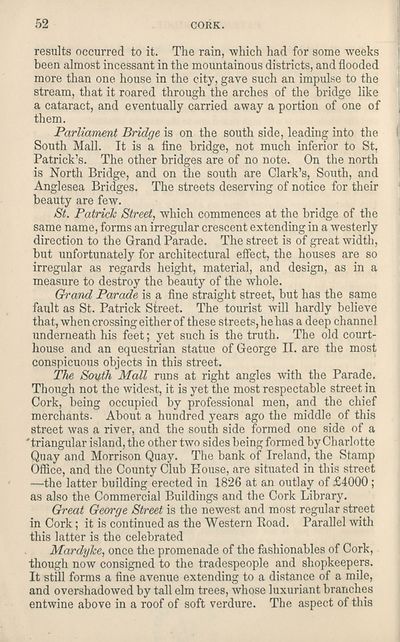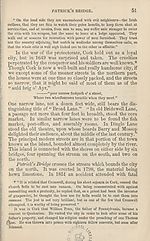Download files
Complete book:
Individual page:
Thumbnail gallery: Grid view | List view

52
CORK.
results occurred to it. The rain, which had for some weeks !
been almost incessant in the mountainous districts, and flooded
more than one house in the city, gave such an impulse to the
stream, that it roared through the arches of the bridge like
a cataract, and eventually carried away a portion of one of j
them.
Parliament Bridge is on the south side, leading into the I
South Mall. It is a fine bridge, not much inferior to St, j
Patrick’s. The other bridges are of no note. On the north
is North Bridge, and on the south are Clark’s, South, and
Anglesea Bridges. The streets deserving of notice for their \
beauty are few.
St. Patrick Street, which commences at the bridge of the
same name, forms an irregular crescent extending in a westerly
direction to the Grand Parade. The street is of great width,
but unfortunately for architectural effect, the houses are so
irregular as regards height, material, and design, as in a
measure to destroy the beauty of the whole.
Grand Parade is a fine straight street, but has the same
fault as St. Patrick Street. The tourist will hardly believe
that, when crossing either of these streets, he has a deep channel
underneath his feet; yet such is the truth. The old court¬
house and an equestrian statue of George II. are the most
conspicuous objects in this street.
The South Mall runs at right angles with the Parade.
Though not the widest, it is yet the most respectable street in
Cork, being occupied by professional men, and the chief
merchants. About a hundred years ago the middle of this
street was a river, and the south side formed one side of a
'triangular island, the other two sides being formed by Charlotte
Quay and Morrison Quay. The bank of Ireland, the Stamp
Office, and the County Club House, are situated in this street
—the latter building erected in 1826 at an outlay of £4000;
as also the Commercial Buildings and the Cork Library.
Great George Street is the newest and most regular street
in Cork; it is continued as the Western Road. Parallel with
this latter is the celebrated
Mardyke, once the promenade of the fashionables of Cork,
though now consigned to the tradespeople and shopkeepers.
It still forms a fine avenue extending to a distance of a mile,
and overshadowed by tall elm trees, whose luxuriant branches
entwine above in a roof of soft verdure. The aspect of this
CORK.
results occurred to it. The rain, which had for some weeks !
been almost incessant in the mountainous districts, and flooded
more than one house in the city, gave such an impulse to the
stream, that it roared through the arches of the bridge like
a cataract, and eventually carried away a portion of one of j
them.
Parliament Bridge is on the south side, leading into the I
South Mall. It is a fine bridge, not much inferior to St, j
Patrick’s. The other bridges are of no note. On the north
is North Bridge, and on the south are Clark’s, South, and
Anglesea Bridges. The streets deserving of notice for their \
beauty are few.
St. Patrick Street, which commences at the bridge of the
same name, forms an irregular crescent extending in a westerly
direction to the Grand Parade. The street is of great width,
but unfortunately for architectural effect, the houses are so
irregular as regards height, material, and design, as in a
measure to destroy the beauty of the whole.
Grand Parade is a fine straight street, but has the same
fault as St. Patrick Street. The tourist will hardly believe
that, when crossing either of these streets, he has a deep channel
underneath his feet; yet such is the truth. The old court¬
house and an equestrian statue of George II. are the most
conspicuous objects in this street.
The South Mall runs at right angles with the Parade.
Though not the widest, it is yet the most respectable street in
Cork, being occupied by professional men, and the chief
merchants. About a hundred years ago the middle of this
street was a river, and the south side formed one side of a
'triangular island, the other two sides being formed by Charlotte
Quay and Morrison Quay. The bank of Ireland, the Stamp
Office, and the County Club House, are situated in this street
—the latter building erected in 1826 at an outlay of £4000;
as also the Commercial Buildings and the Cork Library.
Great George Street is the newest and most regular street
in Cork; it is continued as the Western Road. Parallel with
this latter is the celebrated
Mardyke, once the promenade of the fashionables of Cork,
though now consigned to the tradespeople and shopkeepers.
It still forms a fine avenue extending to a distance of a mile,
and overshadowed by tall elm trees, whose luxuriant branches
entwine above in a roof of soft verdure. The aspect of this
Set display mode to:
![]() Universal Viewer |
Universal Viewer | ![]() Mirador |
Large image | Transcription
Mirador |
Large image | Transcription
| Antiquarian books of Scotland > Ireland/Irish > Black's guide to Killarney and the south of Ireland > (64) |
|---|
| Permanent URL | https://digital.nls.uk/118861436 |
|---|
| Description | Thousands of printed books from the Antiquarian Books of Scotland collection which dates from 1641 to the 1980s. The collection consists of 14,800 books which were published in Scotland or have a Scottish connection, e.g. through the author, printer or owner. Subjects covered include sport, education, diseases, adventure, occupations, Jacobites, politics and religion. Among the 29 languages represented are English, Gaelic, Italian, French, Russian and Swedish. |
|---|

